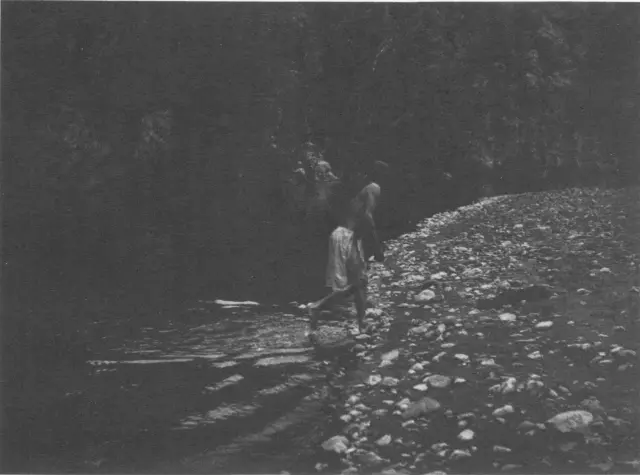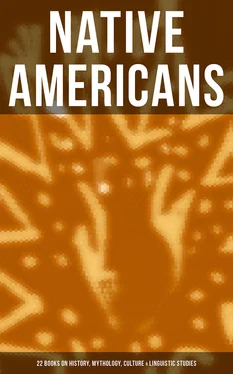The Apache-Mohave call themselves Apátĭĕh, which means, simply, "people." The Walapai, another Yuman tribe farther north, whose dialect resembles that of the Apache-Mohave more closely than do the dialects of the Mohave and the Yuma, also call themselves Apátĭĕh. Although the pronunciation of this word is indicated more nearly correctly by this spelling than by "Apache," only a trained ear can distinguish the difference in sound when the average Yuman Indian utters it. Etymologically it comes from apá, "man," and the plural suffix -tĭĕh.
The mountain fastness of the Apache in Arizona permitted easiest approach from the south and the west for all who wished to seek peace or revenge. The Apache-Mohave, living as Apache in close affiliation, were on the western border of this stronghold, whence they made raids upon several other Yuman groups, north, west, and south, in company with the Apache. They were also the first to be attacked by enemies waging offensive warfare, hence any name by which they designated themselves might readily have been transmitted to the whole Apache group. Early Spanish missionaries alluded to the Apache-Mohave as true Apache. Contradistinguished from the Apache proper, the Apache-Mohave are called Yavapai and Yavapĕh by their congeners of the Colorado river, a term that has been employed by early writers, misled through the close association of the Apache-Mohave with the Apache, to designate also the latter people. It is further evident that the term Apache came to be applied to this great division of the Athapascan family indirectly, as its component tribes are not known by that name in any of the Indian languages of the Southwest, and there is no evidence of its being of other than Indian origin.

At The Ford - Apache
Since known to history, the many bands of Apache have occupied the mountains and plains of southern Arizona and New Mexico, northern Sonora and Chihuahua, and western Texas—an area greater than that of the states of New York, Pennsylvania, New Jersey, Connecticut, Massachusetts, Vermont, Maine, Ohio, North Carolina, South Carolina, and West Virginia. They were always known as "wild" Indians, and indeed their early warfare with all neighboring tribes, as well as their recent persistent hostility toward our Government, which precipitated a "war of extermination," bear out the appropriateness of the designation. An admission of fear of anything is hard to elicit from the weakest of Indian tribes, but all who lived within raiding distance of the Apache, save the Navaho, their Athapascan cousins, freely admit that for generations before their subjugation the Apache were constantly held in mortal terror.
Through the constant depredations carried on against the Mexican settlements in northern Sonora and Chihuahua, under the leadership of Juan José, an Apache chief educated among the Mexicans, those two states were led, in 1837, to offer a bounty for Apache scalps. The horror of this policy lay in the fact that the scalp of a friendly Indian brought the same reward as that of the fiercest warrior, and worse still, no exception was made of women or children. Nothing could have been more effective than this scalp bounty in arousing all the savagery in these untamed denizens of the mountains, and both Mexico and the United States paid dearly in lives for every Apache scalp taken under this barbarous system. Predatory warfare continued unabated during the next forty years in spite of all the Mexican government could do. With the consummation of the treaty of Guadalupe Hidalgo, in 1848, the Apache problem became one to be solved by the United States as well.
In 1864, under General James H. Carleton, the "war of extermination" was begun in a most systematic manner. On April 20 this officer communicated a proposal of co-operation to Don Ignacio Pesqueira, Governor of Sonora, saying: "If your excellency will put a few hundred men into the field on the first day of next June, and keep them in hot pursuit of the Apaches of Sonora, say for sixty or ninety days, we will either exterminate the Indians or so diminish their numbers that they will cease their murdering and robbing propensities and live at peace."
This request was met. The settlers in Arizona, under agreement, placed a force in the field provisioned with army supplies. Several hundred Pima, Papago, and Maricopa Indians also were supplied with guns, ammunition, and clothing, and pressed into service; but a year's effort netted the combined forces little gain. Although two hundred Apache were killed and many head of stolen stock recovered, practically no advance toward the termination of hostilities was accomplished.
In April, 1865, Inspector-General Davis arranged a conference at the Copper Mines in New Mexico with Victorio, Nané, Acosta, and other chiefs, among whom were Pasquin, Cassari, and Salvador, sons of Mangas Coloradas, through which he learned of the existence of dire destitution among the Apache and a desire for peace on condition that they be permitted to occupy their native haunts. But the Government had adopted a policy of removal by which the Arizona Apache desiring peace should join the Mescaleros at the Bosque Redondo in New Mexico. To this they flatly refused to agree, and the warfare continued.

The Bathing Pool - Apache
Practically all the Apache were assembled in Arizona in 1865, and waged hostilities with renewed energy for the next five years, being joined by the Walapai in 1868. The close of this period found the situation quite as unsettled as ever.
On June 4, 1871, General George Crook was placed in command. Crook was not an exterminator. In the fall of the same year he said:
"I think that the Apache is painted in darker colors than he deserves, and that his villainies arise more from a misconception of facts than from his being worse than other Indians. Living in a country the natural products of which will not support him, he has either to cultivate the soil or steal, and as our vacillating policy satisfies him we are afraid of him, he chooses the latter, also as requiring less labor and being more congenial to his natural instincts. I am satisfied that a sharp, active campaign against him would not only make him one of the best Indians in the country, but it would also save millions of dollars to the Treasury, and the lives of many innocent whites and Indians."
Crook's policy was one of peace, but he made it plain to the Indians that if they did not agree to peace when liberal terms were offered, they could expect a campaign against them hitherto unequalled in vigor. It was thus that by 1873 the Tontos, Coyoteros, and Apache-Mohave were subdued and the backbone of Apache resistance broken.
The Apache-Mohave and the Tontos were placed on a reservation on the Rio Verde; the Coyoteros were taken to the White Mountain district near Fort Apache; the Pinaleños and parts of other bands surrendered and were established at San Carlos; in all, approximately three thousand Apache had been brought under control. About one thousand hostiles yet remained in the mountains, but by 1874 they had become so nearly subjugated as to make it seem advisable to transfer the Arizona reservations from the War Department to the Office of Indian Affairs, which was done. The policy of the Indian Office from the beginning had been to concentrate the various bands upon one reservation at San Carlos. Disaffection arose between different bands until this became a despicable place to nearly all, while continued adherence to the removal policy drove the Chiricahua from their southern Arizona reservation to seek refuge with the Ojo Caliente Apache in southwestern New Mexico, in 1876, although they had been living in comparative peace for four years. In 1877 these Chiricahua and the Ojo Caliente band were forcibly removed to San Carlos, but while en route Victorio and a party of forty warriors made their escape. In September of the same year three hundred more fled from San Carlos and settler after settler was murdered. In February, 1878, Victorio and his notorious band surrendered at Ojo Caliente, but gave notice that they would die fighting before submitting to removal to San Carlos. The major portion of the three hundred Chiricahua who had left San Carlos surrendered at Fort Wingate, New Mexico, shortly before. All these were taken to the Mescalero reservation in New Mexico.
Читать дальше














